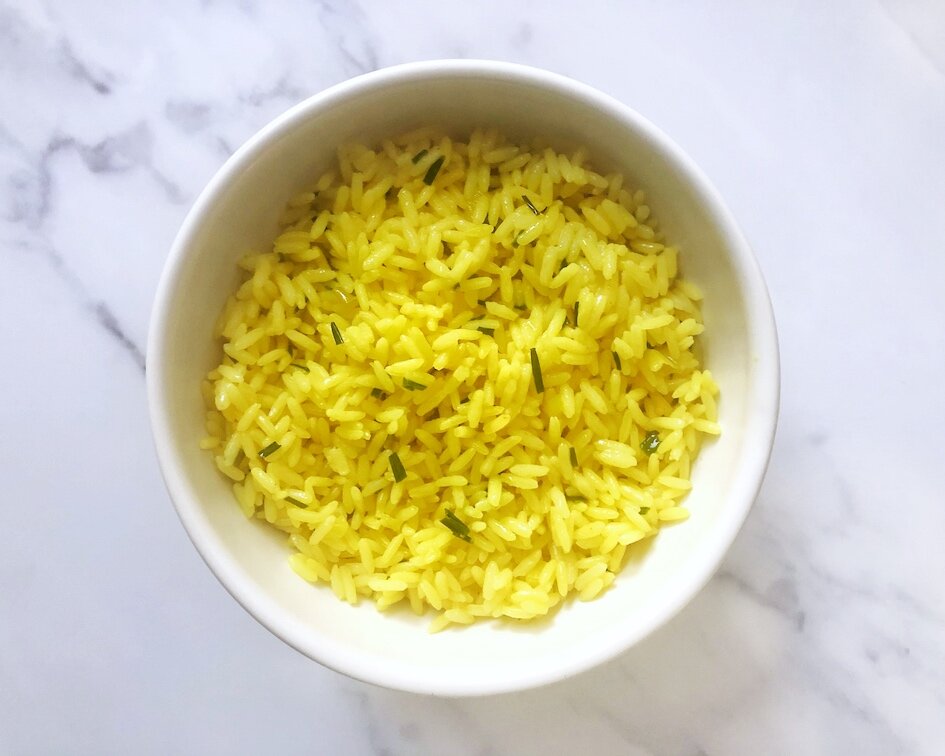Turmeric Rice
GLUTEN FREE · VEGAN OPTION · NUT FREE
The ultimate flexible menu staple, turmeric rice has been a constant in my weekly meal rotation for absolute years. Having to go without it during strict AIP/Paleo phases was always difficult, but thankfully it has proven to be something I tolerate very well, hence its reintroduction and repetition. The addition of turmeric turns this otherwise rather standard side dish into a vibrant bowl of anti-inflammatory goodness.
Extremely versatile, this dish is a great accompaniment to meat or veggies, and can be made easily with minimum time and effort.
Ingredients
Rice
Any rice will do for this recipe. I have used a white parboiled long-grain variety.
Although rice is often one of the first foods that come to mind for any kind of tummy trouble, because it is a grain it is completely removed from many gut-healing diets (including the Specific Carbohydrate Diet, GAPS, Paleo and AIP diets). However, when it comes to the reintroduction of foods after being grain-free, white rice is one of the best-tolerated. Everyone is different, and some people may always be sensitive to rice of course, but for many, it is the first grain they are able to re-incorporate.
Rice also has a very useful role to play in gut health. When cooked rice has cooled, it is a wonderful source of something called resistant starch. This resistant starch works in a similar way to soluble, fermentable fibre, helping to feed the good bacteria in your gut and increasing the production of short-chain fatty acids such as butyrate (read the ghee paragraph below for more on this), which play an important role in gut health.
Rice naturally contains resistant starch, but this increases when rice is left to cool, which is great news for using up any leftovers!
Turmeric
A key anti-inflammatory player in this dish, and the source of the rice’s gorgeous yellow colour. For a full rundown on turmeric’s hero spice status, click here.
Ghee
Possibly one of my favourite ingredients ever! Ghee has a lovely nutty taste and is an excellent alternative to butter, particularly in savoury cooking. Due to the removal of the milk solids, it is both lactose-free and casein-free and so is very well-tolerated, although may still need to be avoided by those with severe dairy allergies (in which case, olive oil would be a suitable alternative, making the recipe dairy-free).
Ghee is also a key ingredient in a gut-healing diet as it contains butyrate: a source of energy for the cells lining the colon, has anti-inflammatory properties, and can improve intestinal permeability.
Bone broth
A gut-healing superstar, bone broth is full to the brim with nutrients, minerals and amino acids. It is rich in protein and contains collagen, glutamine, glucosamine, glycine and chondroitin, all of which help build and strengthen your bones and joints, as well as supporting the lining of the gut and improving intestinal permeability (leaky gut).
Bone broth also adds flavour to food, much as stock cubes do! I find the most convenient way to add it to my cooking, is to pour it into ice cube trays and then simply pop the ice cubes into the dish as it is cooking.
Spring onions (optional)
Spring onions, green onions, scallions - many names for this fresh-tasting ingredient, which also just happens to need a lot less chopping effort than a regular onion: bonus!
Rice can often be rather bland, but these add a lovely flavour and just elevate the dish. Leave out for low-FODMAP.
Chives (optional)
For an extra hit of freshness and flavour (not to mention a little contrasting colour), I like to stir through some finely-chopped chives at the end of the cooking. To make the recipe low-FODMAP, however, leave these out.
Salt and pepper
Changes & Substitutions
Make it vegan?
You can easily make this recipe dairy-free by swapping the ghee with olive oil, and if you opt for a vegetable stock/broth or plain filtered water instead of the bone broth then you have a fully vegan version.
Make it low-FODMAP?
This recipe can easily be made low-FODMAP by simply leaving out the spring onions and chives.
Serving Suggestion
Turmeric rice is a great accompaniment to:
Steamed veggies
Your favourite salad

TURMERIC RICE
Ingredients
- 1 Tbsp ghee (or olive oil)
- 2 spring onions, finely chopped (optional)
- 1 cup rice
- 2 cups bone broth (can also use vegetable broth or just plain water)
- 1/2 tsp turmeric
- Salt and pepper, to taste
- Chives, finely chopped (optional)
Instructions
- Add the ghee and spring onions (if using) to a saucepan over medium heat.
- Gently sauté the onions for 2-3 minutes, until they soften (without letting them turn brown).
- Add in the rice and stir so that the ghee coats the rice grains and the onions are evenly distributed.
- Add the water, turmeric, salt and pepper and stir through gently.
- Cover the saucepan and leave to cook on medium heat for about 15-20 minutes.
- Once most, but not all, of the water has been absorbed, add in the chives and stir through.
- Remove the saucepan from the heat. Fold a tea towel or some kitchen paper and place it tautly over the top of the saucepan, placing the pan lid on top.
- Leave covered for about 10 minutes, then serve.



